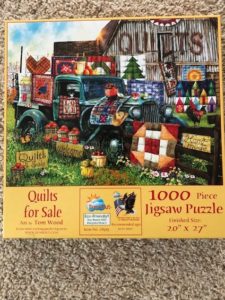I’ve always loved jigsaw puzzles, whether putting them together by myself, with my children, or with my grandchildren. Maybe that’s why I also write and read mysteries. Recently, I thought about how my efforts in solving a jigsaw puzzle were like writing a mystery.
One of the most popular questions posed to mystery writers is, “How do you write a novel?” Frankly, that is a very complicated question, and it’s somewhat different with each novel I write. In general, however, I go through a similar routine that works for me. It’s a lot like working a jigsaw puzzle.
 In the next few weeks, I’m planning to answer that question using the jigsaw puzzle I’m currently putting together. It’s a 1000-piece puzzle called “Quilts for Sale,” and the artist is Tom Wood. It’s distributed by SunsOut.com, and if you’re interested in jigsaw puzzles, I’ll put a link to their website at the end of this blog. I use these photos, by the way, with their permission. At the same time, I’m writing a mystery, so far, unnamed.
In the next few weeks, I’m planning to answer that question using the jigsaw puzzle I’m currently putting together. It’s a 1000-piece puzzle called “Quilts for Sale,” and the artist is Tom Wood. It’s distributed by SunsOut.com, and if you’re interested in jigsaw puzzles, I’ll put a link to their website at the end of this blog. I use these photos, by the way, with their permission. At the same time, I’m writing a mystery, so far, unnamed.
My first step is to pull all the pieces of the puzzle out of the box and turn them over—1,000 pieces. I need to see where everything is, and sometimes when a puzzle has an area of sky or a large building like this one does, I sort those pieces together. I have a friend who does not do that; she simply pulls the pieces out of the box and starts putting them together, pulling more out as she goes. If she ever wrote a book, she’d be a “pantser,” writing without an outline and going where the characters take her. I like to pull out all the pieces and set them right-side-up, like the “outliner” I am as a writer. I need to see the big picture and the details too.
For me, putting all the pieces on the table resembles the thinking part of a book. Before I even begin writing a mystery, I need  to do a great deal of thinking. I can’t skimp on this step, because it affects everything that comes after. Daytime, sleep time, while I’m washing a few dishes, or on my way to the grocery store, I’m thinking about the puzzle pieces of a new story.
to do a great deal of thinking. I can’t skimp on this step, because it affects everything that comes after. Daytime, sleep time, while I’m washing a few dishes, or on my way to the grocery store, I’m thinking about the puzzle pieces of a new story.
What will my main point be? Who is my protagonist? Who is the villain? What are the problems my protagonist faces? How am I going to throw roadblocks in her way? What point-of-view should I use? What are the motives of my characters? What are their back stories? What is the timeline for events? Every piece of the puzzle must fit together perfectly, or I’ll experience a situation where I must change multiple pieces to make them all go together. Occasionally, I do that with my jigsaw puzzle too—put a piece in the wrong place, necessitating multiple changes.
 My Endurance mysteries took me down a familiar road with a protagonist who was a retired school teacher in a small town. Adding a mystery from the past and villains who had motives to hide fell into place easily. Backstories and timelines are where writers need to be careful, because it’s easy to change a detail about a character (Were her eyes brown back on page 22?) I need math skills for dates characters were born and events that influenced their lives. This is particularly true when they must be a certain age at a certain time. My most recent manuscript, A Death at Tippitt Pond, has a murder in the past, decades earlier, so now I’m balancing characters in the past and the present. This puzzle gets more and more complicated.
My Endurance mysteries took me down a familiar road with a protagonist who was a retired school teacher in a small town. Adding a mystery from the past and villains who had motives to hide fell into place easily. Backstories and timelines are where writers need to be careful, because it’s easy to change a detail about a character (Were her eyes brown back on page 22?) I need math skills for dates characters were born and events that influenced their lives. This is particularly true when they must be a certain age at a certain time. My most recent manuscript, A Death at Tippitt Pond, has a murder in the past, decades earlier, so now I’m balancing characters in the past and the present. This puzzle gets more and more complicated.
 Research. Once the pieces of the puzzle are sitting on the table, I need to see what comes next. This is like discovering places in the novel that will need some research. So, I interview people, do library research, check the internet, and fill in all the missing spots. Obviously, the puzzle-maker sent me all the pieces I need to make a full picture, so this is one of the places where I veer off a bit from the analogy. But, you know, I might have dropped a few pieces on the floor, so I check the carpet for those missing pieces, just like I check with people and resources for the missing information I need for my book.
Research. Once the pieces of the puzzle are sitting on the table, I need to see what comes next. This is like discovering places in the novel that will need some research. So, I interview people, do library research, check the internet, and fill in all the missing spots. Obviously, the puzzle-maker sent me all the pieces I need to make a full picture, so this is one of the places where I veer off a bit from the analogy. But, you know, I might have dropped a few pieces on the floor, so I check the carpet for those missing pieces, just like I check with people and resources for the missing information I need for my book.
Over the past six years since I’ve been writing mysteries, I’ve learned about so many people, places, and subjects through research and interviews. Coroners, district attorneys, mental health experts, fire chiefs, doctors, historical home renovators, gun shop owners, bankers, detectives, police chiefs, and lawyers top the beginning of a long list of people. I find it amazing that so many experts are willing to share their knowledge with me. Perhaps they, too, love to talk about what they do.
I’ve also researched poisons, guns, stabbings, objects kept from cold cases, arson, DNA, furniture-making, organizing art exhibits, adoption, genealogy, and so many other topics that were never in my pre-author memory storage. It’s like looking at a piece of the puzzle that contains an object I’ve never seen before and thinking about where it might fit in the overall picture. Currently, I’m learning about the art world, a universe about which I know very little.
How these puzzle pieces fit together comes next. The hardest and longest part of writing a novel for me is this first part. Thinking, thinking, thinking. Staring at 1,000 puzzle pieces might make me feel like the job is overwhelming; considering writing 75,000 words feels the same. But one piece at a time works in both situations.
Next: Putting together the border … outlining the mystery.
To explore the world of puzzles at Sunsout.com, click here: SunsOut

Great analogy, Susan. I think it’s like a jigsaw puzzle for the reader, too. Quick story. My grandfather loved puzzles. He was at an advanced age and could see well, so he wore glasses and used a magnifier. I walked into the dining room one day and found him with a hammer, trying to force a piece into the puzzle. LOL I guess authors must be careful, too, or we might try to force a piece of the story into the wrong place. Thank you so much for sharing!
Oh, my gosh. That is such a hilarious story, Marja. Not sure I’ve ever used a hammer on a puzzle or a story, but I’ll keep that in mind. Thanks for stopping by and commenting!
Susan, I am a jigsaw puzzle fan too so this analogy is perfect! Very helpful to a newbie like me. I’m eager to read about your approach to the border!
Ah, the border. That is my favorite part. Coming up in about a week. Keep writing yourself!
Great analogy! I love the “quilts” puzzle…have fun with it. 🙂
Thanks, Joanne. I used to be a seamstress, but quilts …not so much. However, so many cousins and aunts were quilt makers, so I thought this might be the closest I could get.
I love puzzles and mysteries!
Me too, Vicki. We’re obviously intelligent and discriminating people! (-: